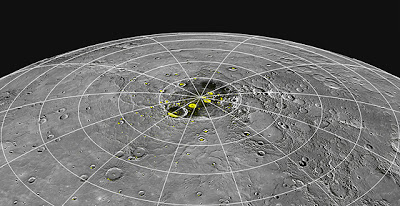

| Visitors Now: | |
| Total Visits: | |
| Total Stories: |

| Story Views | |
| Now: | |
| Last Hour: | |
| Last 24 Hours: | |
| Total: | |
Scientists discover 20 billion to 1 trillion tons of water ice on Mercur
From
Mercury, the smallest and innermost planet in our solar system, revolves around the sun in a mere 88 days, making a tight orbit that keeps the planet incredibly toasty. Surface temperatures on Mercury can reach a blistering 800 degrees Fahrenheit — hot enough to liquefy lead.
Now researchers from NASA, MIT, the University of California at Los Angeles and elsewhere have discovered evidence that the scorching planet may harbor pockets of water ice, along with organic material, in several permanently shadowed craters near Mercury’s north pole.
Mapping the planet’s surface is a challenging task, as the craft must weather the sun’s intense radiation, which can “play havoc with electronics,” Zuber says. What’s more, the probe moves from pole to pole in an elliptical orbit, making for an extremely tricky mapping mission, both dynamically and thermally. Despite these challenges, MESSENGER’s onboard laser altimeter has amassed more than 10 million laser pulses that have been used to map topography and measure the near-infrared reflectance of the surface.
Last year, researchers analyzed the probe’s topographic observations and created a high-resolution map of Mercury; they then overlaid previous radar observations. They found that the bright regions detected in radar lined up with permanently shadowed craters at the planet’s north pole — regions that never see the sun, and which are potentially ideal places for ice to survive. This finding was one more piece of evidence that Mercury might harbor water ice.
In this latest analysis of MESSENGER’s observations, scientists believe they have found conclusive evidence for water ice on Mercury, although the data was at first puzzling.
Perspective view of Mercury’s north polar region with the radar-bright regions shown in yellow. Image: NASA/Johns Hopkins University Applied Physics Laboratory/Carnegie Institution of Washington
Three independent lines of evidence support this conclusion: the first measurements of excess hydrogen at Mercury's north pole with MESSENGER's Neutron Spectrometer, the first measurements of the reflectance of Mercury's polar deposits at near-infrared wavelengths with the Mercury Laser Altimeter (MLA), and the first detailed models of the surface and near-surface temperatures of Mercury's north polar regions that utilize the actual topography of Mercury's surface measured by the MLA. These findings are presented in three papers published online today in Science Express.
Measurements by the Neutron Spectrometer on the MESSENGER spacecraft show decreases in the flux of epithermal and fast neutrons from Mercury's north polar region that are consistent with the presence of water ice in permanently shadowed regions. The neutron data indicate that Mercury's radar-bright polar deposits contain, on average, a hydrogen-rich layer more than tens of centimeters thick beneath a surficial layer 10 to 20 cm thick that is less rich in hydrogen. The buried layer must be nearly pure water ice. The upper layer contains less than 25 wt.% water-equivalent hydrogen. The total mass of water at Mercury's poles is inferred to be 2 × 10^16 to 10^18 g (20 billion to 1 trillion tons) and is consistent with delivery by comets or volatile-rich asteroids.
Science Express – Thermal Stability of Volatiles in the North Polar Region of Mercury
Science Express – Bright and Dark Polar Deposits on Mercury: Evidence for Surface Volatiles
See more and subscribe to NextBigFuture at 2012-11-30 10:42:11 Source: http://nextbigfuture.com/2012/11/scientists-discover-100-billion-tons-of.html
Source:





Yeah, maybe there’s life on Mercury!
Who cares.